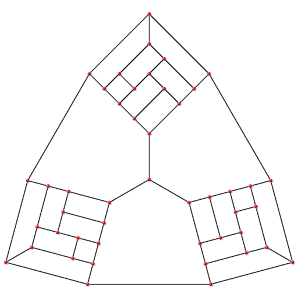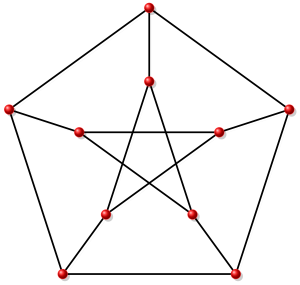En ocasión del 84 aniversario del natalicio del Claude Berge, quien formuló la Conjetura Fuerte de Gráficas Perfectas, presentaremos un dibujo de una gráfica perfecta, la gráfica de Pappus.
Dibujo en formato pdf.
Únicamente utilizamos la librería shadows de TikZ.
\usetikzlibrary{shadows}
El código para generar el dibujo es el siguiente.
\begin{tikzpicture}[
vertex_style/.style={circle,shading=ball,ball color=red,draw=red!80!white,drop shadow={opacity=0.4}},
edge_style/.style={ultra thick, black,drop shadow={opacity=0.4}}]
\useasboundingbox (-5.05,-5.3) rectangle (5.1,5.25);
\begin{scope}[rotate=90]
\foreach \x/\y in {0/1,60/2,120/3,180/4,240/5,300/6}{
\node[vertex_style] (\y) at (canvas polar cs: radius=2.5cm,angle=\x){};
}
\foreach \x/\y in {0/7,60/8,120/9,180/10,240/11,300/12}{
\node[vertex_style] (\y) at (canvas polar cs: radius=5cm,angle=\x){};
}
\foreach \x/\y in {0/13,60/14,120/15,180/16,240/17,300/18}{
\node[vertex_style] (\y) at (canvas polar cs: radius=1.25cm,angle=\x){};
}
\end{scope}
\foreach \x/\y in {13/16,14/17,15/18}{
\draw[edge_style] (\x) -- (\y);
}
\foreach \w/\x/\y/\z in {1/7/14/18,2/8/15/13,3/9/16/14,4/10/17/15,5/11/18/16,6/12/13/17}{
\draw[edge_style] (\w) -- (\x);
\draw[edge_style] (\w) -- (\y);
\draw[edge_style] (\w) -- (\z);
}
\foreach \x/\y in {7/8,8/9,9/10,10/11,11/12,12/7}{
\draw[edge_style] (\x) -- (\y);
}
\end{tikzpicture}


